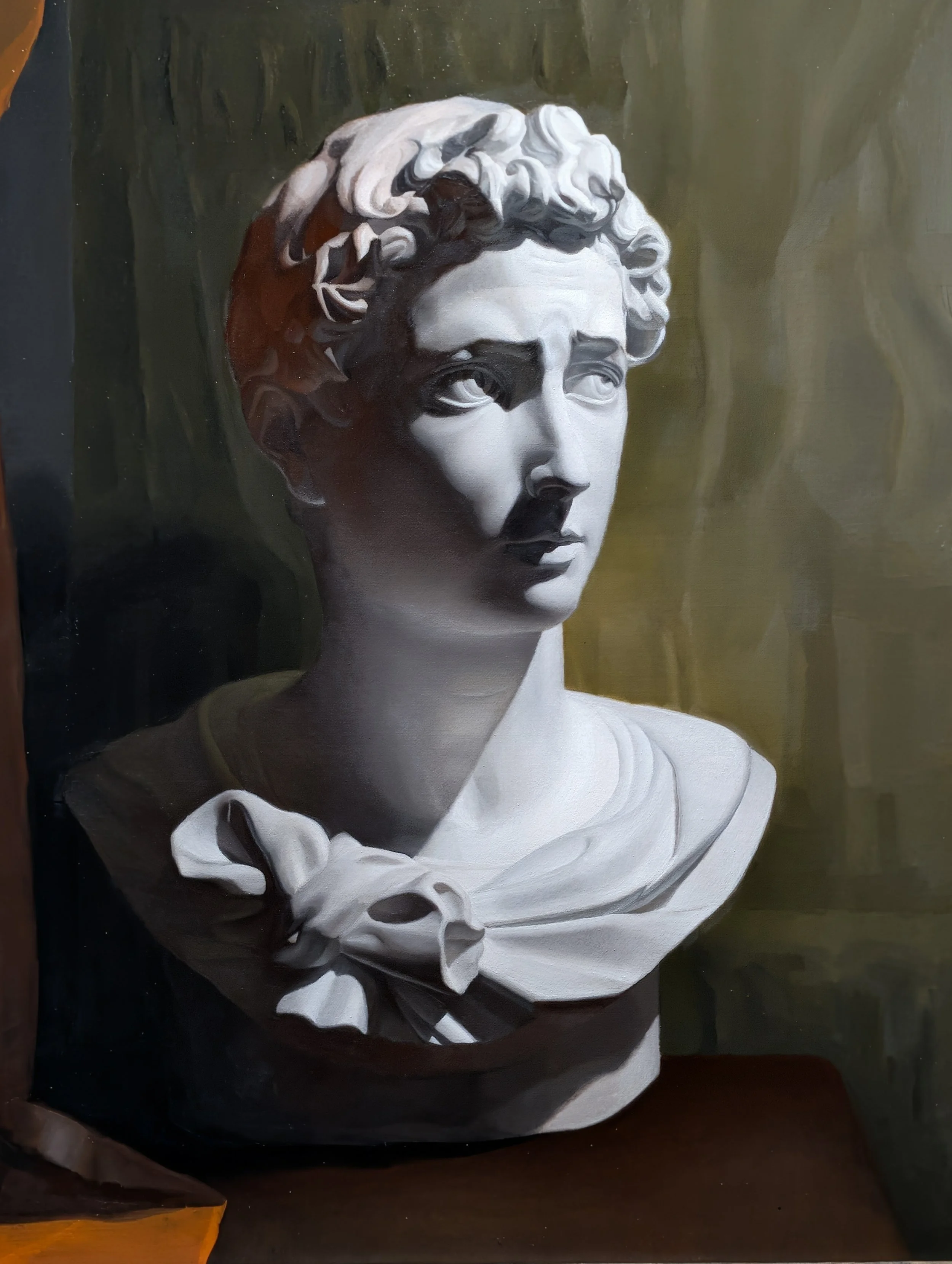The Dragon of Time
Jonathan Soriano, 2025
Warrior Saint George has saved the city of Silene and its princess from an insatiable dragon. As his life continues as a venerated Roman soldier, another adversary approaches: Time. As its passage leaves wrinkles on his face and erodes his physical resilience, what endures beyond his final foe?
INSPIRATION
MATERIALS
Cast: Caproni Plaster Cast
Oil Paint:
Panel: Artefex Allinpanel Oil Primed Linen Panel (18”x24”)
Brushes: Utrecht Manglon Synthetics
PROCESS
Clockwise from top left: 1st Painting, Dead Coloring, Color Study, Preliminary Drawing
CONCLUSIONARY NOTES
General
Do things correctly the first time! Do not be too general or transparent unless necessary. This will be more efficient in the long run. When in doubt, use more paint! When struggling with fiddling a section, no harm in taking it back to a previous stage and trying again… with more paint!
Care about your background. It will compliment the focal point much better than an unthoughtful mess.
Trust your unconscious instincts more and learn to recognize when you make decisions so in the future you can make those decisions on purpose.
Shadows have their own light logic that will add a lot of form if defined. Look for the light source within the dark spaces and build out from the reflected light.
Stop accidentally connecting things that will look better not connected. For example, if the shadow ends directly at a neat corner, it will look unnatural so take artistic license.
Beware of personal tendency to make nose and chin too small…
Keep brushes used for darks and brushes used for lights separate to avoid contamination.
Wash brushes with soap like you’re shampooing your hair. Being relatively rough and cleaning out deep within the hairs will preserve the bouncy feel of the brush and protect the ferrule. Be aware brushes are meant to be replaced eventually and you cannot preserve them forever.
Color
Color is the product of three factors: Hue, Chroma, and Value. After making a guess on color, focus on which variable you are adjusting to reach the desired outcome, preferably one variable at a time.
Introducing a highly chromatic key will allow you to use higher chroma in other areas of the painting. Once again, relationships are everything. Very specific color does not matter. You can be relatively inaccurate with hue as long as your value is correct!
Highest chroma notes on a form are usually found within the half-tones.
Cohesive color can be gained by pulling from the light source colors already defined elsewhere in the painting. For example, reflected light from the green background will find its way into the light logic of shadows. This will make parts of your shadows look more yellow compared to their blue neighbors or more brown compared to their purple neighbors. Paint the light’s bounce!
A white cast still displays temperature shifts within the light depending if it is facing away or toward the light source. However, higher chroma will be found in the shadows which are collecting reflected light from the environment.
Strong preference for adjusting color on the panel after initial paint guess is made. Premixes are used for a ballpark but will dial my statements in with direct adjustment.
Process
Be forward thinking on end product while working on earlier layers. It is not necessary to fully state an area in first painting when it will be lost later. HOWEVER, it is MUCH easier to make a defined area softer than a soft area more defined in a second painting layer. Pick your suffering.
When working with lead white, start with putting down a layer of white as a ground in your light areas. It will take 4-5 layers to get it to its brightest value anyway so start that drying process early.
Create more general planes during dead coloring and allow yourself more dead coloring specificity within areas of interest.
Dead coloring is just preliminary mass drawing with transparent paint. Treat it with care and use it to figure out if your major shapes and proportions are correct before iterating further.
Topographical mapping is inferior to larger plane change mapping and will result in inefficient, repetitive statements. Break that habit for your next project. See right cheek vs. right forehead in first painting for demonstration of the two approaches.
Hard edges within first painting and modeling is acceptable only if the neighboring values are close together. Otherwise, keep edges as soft as possible to allow for drawing modifications. Hard edges should be reserved for special effects.
Load more paint than expected when working opaquely, especially while second painting into a couch layer. Couching is a thin glaze and can be used to re-generalize and/or tint an area. If the underlying layer is strong, this may be sufficient to soften and push back the area.
There are three ways to make a form feel like it is turning away from you: 1) value - make the far edge plane darker, 2) mechanical softening - place paint down next to each other and run a dry brush along the connecting edge, 3) discreet planes - add transitional value planes in appropriate order to fade away.
Resist the urge to blend at any stage before second painting!

